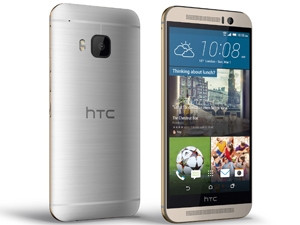
When HTC announced its new flagship phone, the HTC One M9, at the Mobile World Congress in Barcelona in March, opinions were divided. Both analysts and journalists were hoping to see an innovative device, but were confronted with a smartphone that seemed to be more of an evolution than a revolution. So how suitable is the One M9 for business? And how does this expensive and high-end device stack up to competitive high-end smartphones, as well as its predecessor?
We got to work with a European review-sample of the HTC One M9. We deployed it for all sorts of typical business tasks and activities, such as Web browsing, communicating via mail and Skype, handling various office documents, watching videos and installing dozens of apps.
To determine how fast the new M9 is, we ran two generic system benchmarks and one specific graphics-oriented test. To measure how long a fully-charged battery would last, we confronted it with two separate torture tests. In order to pinpoint the quality of the screen, we used dedicated measuring equipment to map the One M9's brightness, contrast and colour reproduction. Camera quality was ascertained by taking various pictures in different scenarios and settings. The One M9's test results were then compared to those of other high-end smartphones from competitive brands as well as the HTC One M8.
Look and feel: solid design
The design of the new HTC One M9 is basically identical to that of the One M8. It features a brushed aluminium backside that slightly curves into the device's edge. As a result, it offers a great feel in the hand and comes across as very durable and sturdy. It is by far one of the most well-built smartphones available. The M9 should, therefore, have no problem at all with rough handling at the office or during a demanding business trip overseas.
Compared to its predecessor, the M9 is marginally smaller in both height (144.6mm) and width (69.7mm), but slightly thicker (9.61mm). Still, it feels like a big phone due to relatively thick edges around the screen and the space that is reserved for the speakers, which sound excellent by the way.
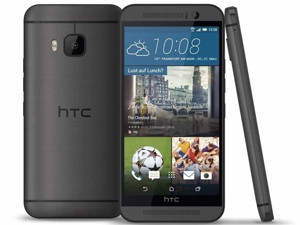
HTC also decided to move the location of the power button from the top to the side of the One M9 - an excellent choice in our opinion as many One M8 users found that reaching the power button, while holding the device with one hand, was quite difficult. It is now much easier to reach, even if you have relatively small hands.
Because of the success of last year's HTC One M8, the company clearly chose to further build on that instead of coming up with a completely new, innovative design. While we can understand HTC's motivation to do so, we would have liked to see some more novelties in the One M9's look and feel.
Hardware: next generation Snapdragon
HTC's One M9 is the first smartphone to ever reach our test lab that is equipped with the brand new Snapdragon 810 SoC (system-on-a-chip) - Qualcomm's very first 64-bit chip that relies on ARM's Cortex design, instead of Qualcomm's own Krait architecture. It is the successor to the widely used Snapdragon 801 SoC that was featured in many popular 2014 smartphones, like the HTC One M8, Samsung Galaxy S5 and Sony's excellent Xperia Z3.
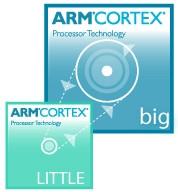
The Snapdragon 810 uses an enhanced implementation of the big.LITTLE concept, which we initially came across in Samsung's Galaxy Alpha and Huawei's Ascend Mate 7 smartphones. The big.LITTLE technology automatically and seamlessly moves workloads to the appropriate cores. During light workload, the four 1.5GHz Cortex A53 cores kick in, while with heavy workload the four 2GHz Cortex A57 cores take over.
With the first implementation, the cores couldn't be individually managed, only per cluster. The Snapdragon 810 can now enable or disable individual cores as required by the workload. It can also use all 8 cores simultaneously. However, because of the extreme drain on the battery, and subsequent heat development, that is very unlikely to ever happen.
The new Snapdragon 810 also features an upgraded GPU - the Adreno 430, which should perform up to 80% better. Qualcomm, has replaced the older generation Adreno 330 GPU.
Besides faster internal hardware, the M9 also houses 3GB of high-speed RAM and comes standard with 32GB storage space. Of that 32GB, about 21GB remains for user files and apps. Storage hungry business users can easily expand that capacity with an optional micro SD card. According to its specs, the M9 should be able to handle up to 2TB, making it very future-proof. It also offers a wide range of wireless connection options like 802.11ac and 2.4GHz/5GHz support, Bluetooth and NFC.
Benchmarks: fast as lightning
To find out how the new Snapdragon 810 CPU and GPU perform in combination with the 3GB of fast RAM, we ran three separate benchmarks. The test results of the HTC One M9 were then compared to those of other high-end smartphones of competitive brands, as well its predecessor.
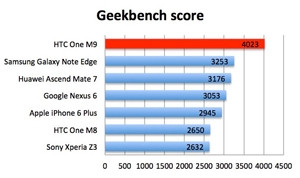
The first benchmark, Geekbench, simulates real-world business and consumer scenarios to determine and quantify the actual (multi-core) processing power. It clearly showed us the raw power of the HTC One M9, since it was able to easily outperform all the other high-end devices we used in this review.
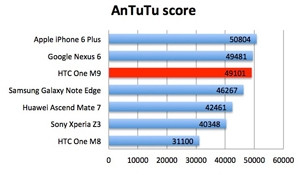
The second benchmark, AnTuTu, was initially developed for Android, but now also supports other mobile operating systems like Apple's iOS and Windows Phone. The benchmark focuses on the CPU, RAM, GPU and I/O performance. This time, Apple's 5.5-inch iPhone 6 Plus (R11 000) and Google's 5.9-inch Nexus 6 (R8 000) devices perform only marginally faster than the HTC One M9. The One M8 is unable to keep up with the rest of the high-end devices, though.
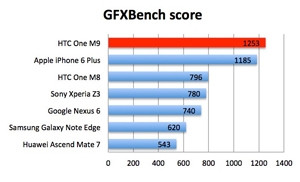
Finally, we ran the GPU-specific GFXBench (Manhattan, onscreen) test to determine how the HTC One M9 handles complex 3D-graphics. Our test results showed that it blows the competition out of their socks, even dethroning the iPhone 6 Plus.
Battery life: unacceptable
Since the One M9 houses more powerful hardware, HTC also upgraded the battery capacity to 2840mAh (up from 2600mAh in the One M8). Since the One M8 was famed for its excellent battery life, we were eager to find out if the One M9 could maintain that reputation.
In order to do so, we ran two separate torture tests that aim to drain the battery of the new HTC One M9 as fast as possible. These tests effectively create a worst-case scenario; the minimum time you can expect the phone to function. The first test simulates continuous business use. The second continuously plays a 1 080p video until there is no energy left.
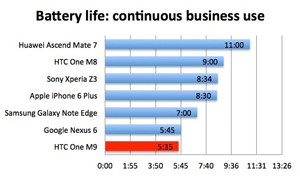
Unfortunately, the excellent hardware performance that the HTC One M9 achieves comes at a painful price. Its maximum battery life, when solely used for non-stop business tasks and activities, is a disappointing five hours and 35 minutes. This score places the One M9 at the bottom position when compared to the other high-end smartphones. The cheaper six-inch Huawei Ascend Mate 7 (R5 800) lasts twice as long on a fully charged battery. The fact that it quits 2.5 hours earlier than its predecessor is also particularly embarrassing.
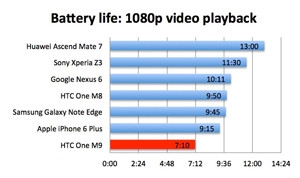
Since a regular day at the office also includes a lunch break and some other idle time, we estimate the HTC One M9 will run out of energy before the end of an eight-hour workday. For an expensive, high-end device this is simply unacceptable.
Its battery life when playing non-stop 1080p video is also considerably shorter than that of other comparable smartphones. Again, the Huawei Ascend Mate 7 can survive the longest of all high-end devices.
Screen: can't match its predecessor
While many of the latest smartphones feature ultra-high resolutions, like 2460x1400, HTC decided to stick with 1920x1080 as featured in the M8. A wise choice by HTC since the difference between those two resolutions is hardly noticeable to the naked eye. It would also have an even more dramatic effect on the battery life and decrease performance.
We initially thought that HTC supplied the One M9 with the exact same five-inch screen as the M8, but after using our SpectraCal C6 colorimeter to get a better look at it, we were proven wrong: for some reason which is beyond our comprehension, HTC equipped the M9 with a lower quality screen than that of the M8.
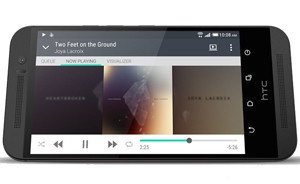
The maximum brightness levels that we measured (472cd/m^2) are lower than those we observed on the M8 (512cd/m^2). Fortunately, the screen contents of the HTC One M9 will still be comfortably visible when the phone is used in direct sunlight, the difference isn't that drastic. Contrast values, however, are a lot worse than what we saw on the One M8, and that's a big disappointment. The HTC One M8 showed excellent contrast levels of 1632:1, but the M9 won't be able to display anything above 910:1.
The difference becomes obvious when putting the M8 and M9 side by side. The colours on the M8 look significantly more vivid and lively than those of the M9. We also noticed an effect called colour shifting when we looked at the M9's screen from a skewed angle. Normally, you would only see this on cheaper, mid-range devices.
We also measured the accuracy of colour reproduction, which is something that semi-professional photo or video enthusiasts consider to be very important. In general, the screen of the One M9 tends to display a light bluish tone. This becomes even more visible when showing Web sites or documents that contain a lot of white spaces. The brighter the screen becomes, the more intense this blue tint will get. Luckily, typical consumers and business users will probably not even notice or be bothered by this imperfection.
All in all, the screen of the HTC One M9 is unable to deliver the same high quality experience as its predecessor. Nonetheless, it remains good enough for the majority of business uses. It offers good brightness levels, acceptable contrast values and a high pixel density of 440ppi. As a result, both images and text look razor sharp.
Camera: expected more
The HTC One M8 featured a 4MP camera that used a technology called Ultrapixel, but was unable to really impress. With the M9, HTC changed its philosophy and simply increased the main camera resolution fivefold. The new 20MP rear camera relies on a Toshiba-made sensor with an effective focal length of 27.8mm and an f/2.2 aperture. It is accompanied by a dual LED-flash and auto-focus functionality. The 20MP sensor has a size of 1/2.5 and its pixels are 1.12 ?m small, which is slightly less than those on the iPhone 6 (1,4um).
In terms of light sensitivity, the sensor in the M9 is inferior to the one on the M8. We're also disappointed that there's no optical image stabilisation (OIS) on board to effectively reduce the effects of shaky hands. OIS is something we'd expect from an expensive, high-end device nowadays. Instead, the One M9 utilises cheaper and inferior digital image stabilisation (DIS) technology to intercept and neutralise tiny vibrations.
After taking numerous test pictures with the 20MP back camera, and analysing them afterwards, we came to the conclusion that for a high-end smartphone with a price tag this high, we'd expect more quality. Obviously, because of the much higher resolution than the HTC One M8, the M9 is able to capture a lot more detail. When compared to the camera of the Samsung Galaxy Note 4, which we praised last year for its great 16MP sensor and OIS, the M9 fell short in quality during our outdoor test.
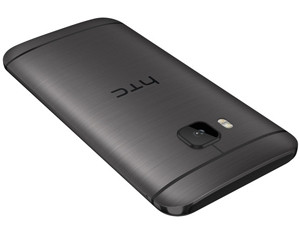
We also tested the HTC One M9's main camera indoors. Again, it comes as no surprise that the M9's camera quality easily surpasses that of its predecessor. It did, however, surprise us that the slightly cheaper (R8 500) Galaxy Note 4 again showed better picture quality and we suspect the lack of OIS in the HTC One M9 is to blame.
We finally shot a series of test pictures in various light deprived scenarios. The older One M8 performed surprisingly well under these conditions as a result of its Ultrapixel technology. Because of relatively large pixels and a highly light-sensitive lens, the M8 manages to keep the ISO levels low and therefore digital noise to a minimum. The HTC One M9, however, isn't as sensitive to light so it needs to compensate with higher ISO levels, resulting in more visual artefacts and lower image quality. The Galaxy Note 4 is able to keep its shutter open longer because of its optical image stabilisation, resulting in far better picture quality than both the HTC devices.
HTC didn't completely get rid of its Ultrapixel technology though, they just moved it to the front camera. As a result, this "selfie" camera performs better than its M8 counterpart, making it perfect for Skype calls. Although the M9's rear camera can't meet our expectations, it is still more than adequate to be used during the occasional corporate meeting, business trip or office birthday party. Just make sure all the lights are turned on.
Verdict
HTC's brand new flagship phone has a lot of good features, like great looks, a well-built exterior, good feel in the hand and excellent sounding speakers. It houses 32GB of (expandable) storage space, adequate support for the latest wireless connectivity options and state-of-the-art hardware that delivers one of the fastest smartphones currently available.
The HTC One M9, unfortunately, also has some serious flaws. Its screen is of a visibly lower quality than that of the One M8 and the main camera is a bit disappointing considering the One M9's high price tag.
Most importantly, the One M9's battery life is simply unacceptable for such an expensive, high-end smartphone. As a result, business users looking for a high-end smartphone with long-lasting battery life should stay clear from the HTC One M9.
Its biggest competitor is its own predecessor - HTC's One M8, which will surely drop in price as a result of the M9's presence, features the exact same build quality and looks, offers considerably longer battery life and even a better screen.
The HTC One M9 was launched in SA this week, with pre-orders opening in May.
Share